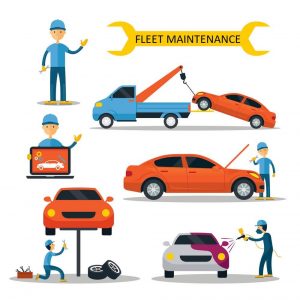 Maintenance of vehicles is a major cost in fleet management for fleet owners. The fleet management strategy can be to maintain the vehicles in house or to outsource the maintenance. One cannot definitely state, one fleet management strategy is better than the other. The company goals and objectives would set the priorities, based on which a company would need to decide to maintain the vehicles in house or to outsource the fleet maintenance.
Maintenance of vehicles is a major cost in fleet management for fleet owners. The fleet management strategy can be to maintain the vehicles in house or to outsource the maintenance. One cannot definitely state, one fleet management strategy is better than the other. The company goals and objectives would set the priorities, based on which a company would need to decide to maintain the vehicles in house or to outsource the fleet maintenance.
Scheduled fleet maintenance
Many make the mistake of underestimating the importance of proper fleet maintenance. This leads to more breakdowns and reducing the lifecycle of a fleet increasing fleet replacement frequency and eventually increasing costs. Maintenance is not limited to replacement of the engine oil and the oil filter, but a complete inspection of the vehicle, vehicle cleaning, inspection and replacement of worn out parts, inspection of tyres, inspection of vehicle body, fluid levels, electricals, etc.Some intending to save maintenance costs, do the minimum and fix fleet issues as and when required or only when mandatory. This will ensure a low routine maintenance cost, but in the long run it will definitely cost more. As this will for sure lead to more wear and tear of parts, sharply increasing the maintenance cost by time, more vehicle breakdowns, reducing the vehicle life cycle and leading to early replacement of fleet vehicles. Fleet replacement cost may not directly be part of fleet maintenance cost, however this is still a cost to be borne by the company and the frequency is a direct result of how the vehicles are maintained and driven.
The diagnostic and various other tools mentioned in the Tools below can definitely assist you in better maintenance of your fleet. For example, we have identified vehicles in regions with bad road and driving conditions, which have not had to undergo an engine overhaul even after driving for 1,000,000 kms and are still in use. At the same time, we have identified vehicles in regions with very good road and driving conditions and the workshop manager’s stating the vehicle had completed its life cycle at 200,000 kms. The most important and major difference in the two fleets is how they were maintained.
Sample maintenance schedule
- Oil change as per manufacturer’s schedule
- Oil filter change as per manufacturer’s schedule
- Air filter cleaning and change as per manufacturer’s schedule. We have noticed many companies only cleaning the air filter at every service schedule. However, the air filter has to be replaced as per manufacturer’s schedule.
- Air conditioner filter cleaning or replacement as per manufacturer’s schedule.
- Brake inspection
- Transmission oil check as per manufacturer’s schedule
- Tyre inspection and Tyre rotation is ignored by many but is not less important. Tyre rotation involves replacement of tyre in use with the spare tyre. This ensures whenever a tyre is replaced with a spare, it maintains a proper drive and balance for the vehicle. Other if the spare tyre is not used in the tyre rotation, whenever it is used for replacing a tyre, it will lead not only lead to improper handling of the vehicle but also improper tyre wear.
- Differential oil check as per manufacturer’s schedule
- Inspection of vehicle body and suspension.
- Inspection and replacement if required of wear and tear parts.
- Inspection of refrigeration units of vehicles with refrigeration.
Workshop productivity & efficiency
This is important for every workshop manager. How does one evaluate the efficiency of the workshop? The ideal efficiency would be different for a dealership and different for a fleet owner, the simple reason is the objective. This generally requires the number of labour hours available, number of labour hours used, work done in hours, etc. You can use the methods in the Tools below to calculate the productivity and efficiency of your workshop.Vehicle to Technician ratio
This is a question asked by every fleet owners, fleet managers and workshop managers who have inhouse fleet maintenance. Unfortunately, there is no standard formula to get this magic number. It depends on various factors, examples,- Is it a fleet of cars or pickups or busses or trucks or a mix?
- Is the fleet new or aged?
- What is the distance driven every day?
- What are the weather conditions?
- What are the road conditions and where are vehicles driven?
- What the actuals work hours of each technician each day?
- What type of maintenance equipment is available?
If you are a functioning workshop, you will have to use historical data and derive a base line and use the base line to improvise and set current requirements. If you are setting up a new workshop you can use the basic method in the ‘Tools’ below to get a baseline to further improvise on. However please consider that this baseline does not tell you how many of these technicians should be mechanics, how many should be electricians and how many should be welders and how many should be helpers.
You can also read through various articles for free on fleet maintenance.
Tools
New tools will be added and updated whenever available, hence keep visiting for new and updated tools

